Shrimp in Chipotle Sauce

I’ve been on a shrimp jag the last couple of weeks. It began with Shrimp in Chipotle Sauce, or Camarones Enchipotlados, from Diana Kennedy’s cookbook The Art of Mexican Cooking. This dish of perfectly cooked shrimp in a slightly sweet tomato-based sauce with spicy, smoky, roasted flavors can be served as a main dish, hot with white rice, or as an appetizer, hot or cold. I like the idea of serving the shrimp cold, as an alternative to the popular appetizer of boiled and chilled shrimp with cocktail sauce. In my fantasy, Shrimp in Chipotle Sauce are served on a veranda, preferably overlooking the ocean, with a cold beverage to women dressed in light cotton sundresses and men in sear-sucker pants and crisp, cotton shirts. (Because it was snowing where I live day before yesterday, it is indeed a fantasy.)
Shrimp in Chipotle Sauce requires a few more steps than shrimp cocktail, but is altogether more complex in flavor. Its slowly building chile heat and smoky flavor come primarily from the chipotles, which are smoke-dried, ripened jalapeños, and somewhat from the adobo sauce they are packed in. Mexican adobo, not to be confused with the same-named Filipino vinegar-based marinade for chicken or pork, is a dark red sauce or paste made with seeded and deveined dried chiles, usually anchos, herbs, garlic, vinegar, sugar, and sometimes tomatoes.
Aside from the chiles and adobo sauce, the key ingredients are fresh lime juice, which the shrimp are marinated in before being cooked for an abbreviated ceviche-style treatment, broiled fresh tomatoes, white wine, and Mexican oregano.
The recipe calls for butterflying the shrimp and leaving the peel on the tail. The first time I made Shrimp in Chipotle Sauce I hadn’t mastered this simple technique and, working quickly to prepare the dish and photograph it before my friend Bahkti arrived for lunch, I gave up after one futile attempt. (I tried butterflying one shrimp from the underside, which is more difficult to do than butterflying the top of the shrimp.) We enjoyed the shrimp hot with plain boiled rice (morisqueta) and finished the meal with Bhakti’s homemade Mexican Wedding Cookies, which she brought in a paper bag with some confectioners’ sugar for shaking.
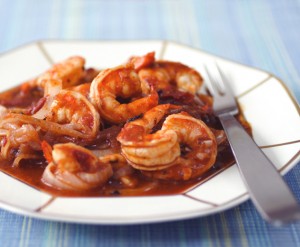
The first time I prepared the shrimp, I peeled them, tail and all, and did not butterfly them.
That same evening, I went to the opening of a new restaurant in town, the Black Krim Tavern. Featured on the menu was the catch of the day served in a curried coconut broth with toasted cashews, red bell peppers, and soba noodles. It sounded so good that I had decided to order it, regardless of what the catch of the day was. The plate arrived with shrimp, butterflied, sitting upright in a shallow bowl of broth with their tails, peel still on, forming a handle and transforming them into a natural finger food.
Prepared this way, versus my fork-to-mouth preparation from earlier in the day, I found myself enjoying the shrimp much more, and was immediately reminded why food is so satisfying eaten when out of hand. It’s direct, sometimes a little sloppy, and sensual. (Like a chaperone, flatware is an intermediary inserted between food and the eater to maintain a certain distance and propriety.) Plus, when butterflied, shrimp automatically divides itself into two portions, or bites, allowing the eater to slow down and get twice the pleasure from one shrimp. Then there is the third morsel, tasting especially of the sea, that is extracted by sucking and/or running your teeth along the bit of shell attached to the tail.
I returned home from the Black Krim Tavern determined to remake Shrimp in Chipotle Sauce, this time with butterflied shrimp and peel left on the tail. Like most things, once tried (or tried again, if needed), it’s not hard. Here are the basic steps for butterflying shrimp:
1. Using a sharp paring knife, you will cut about ¾ of the way into the shrimp, starting at the head region, or the end opposite the tail. You may cut the shrimp while holding it in one hand or working directly on the cutting board.
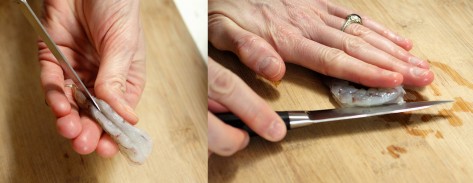
2. Working down the center of the back, toward the tail, continue slicing into the shrimp, but be careful not to cut through the shrimp.

4. Cut just to the tail.
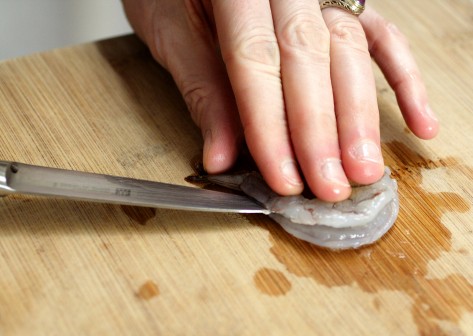
5. You can now open the flesh, like a book.
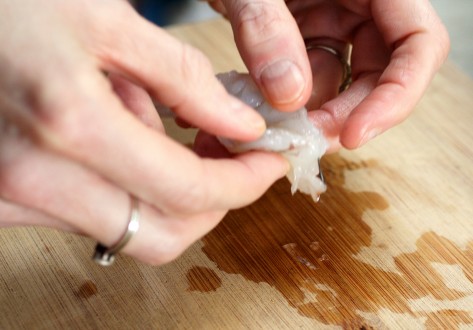
6. If you have not already deveined the shrimp, use the tip of your knife to pry out the black vein that runs along the back of the shrimp (it is the shrimp’s digestive tract), and give the shrimp a final rinse before using.
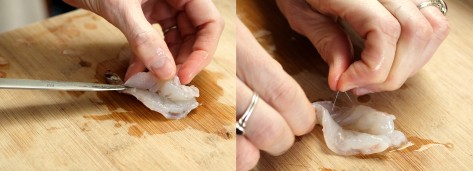
7. Place the butterflied shrimp on the cutting board and gently press it open until it lies flat.
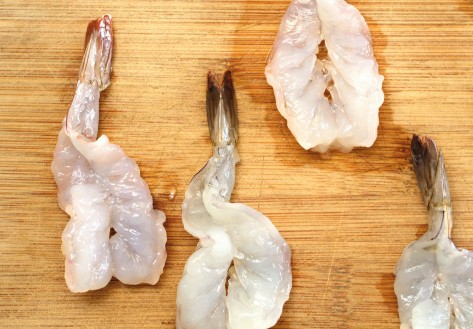
Note to cook: If you don’t have a copy of The Art of Mexican Cooking, you can find several versions of Shrimp in Chipotle Sauce online. (Click herefor the online version I found closest to Diana Kennedy’s recipe. The main difference between them is that Dianna Kennedy specifies ¾ pound tomatoes, rather than “2 medium tomatoes,” and doesn’t give tomatillos, or tomate verde, as an alternative.) Steer clear of recipes that use canned tomatoes as these won’t provide a broiled flavor or those that suggest deseeding the chipotle to lessen the heat. (Diana Kennedy warns against trying to deseed them as they’re very hot; instead, use fewer chiles if you’d like less heat.) The recipe calls for 4 chipotle chiles and some of the sauce they’re packed in. I suggest using 2 chiles for a nice tingle of heat and 3 if you like food decidedly hot. I think 4 chiles would be too hot for anyone who does not regularly use chiles in their cooking. Finally, make sure to slice the onion paper thin if adding them to the pan at the same time the shrimp is added, as Diana Kennedy directs. Alternatively, allow the onions to soften in the skillet before adding the shrimp. (It may be that the onions are meant to be partially cooked, and still a bit crunchy, in this dish; but, this seems anti-intuitive to me. Second guessing the timing of the cooking of the onions, I partially cooked them before adding the shrimp. If anyone knows if the onions are meant to be just wilted for this dish, please me know. )
